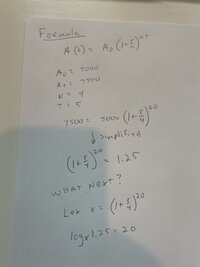Thanks in advance. We are supposed to use logarithms to answer this question.
Question: If interest is compounded monthly, at what annual rate must you invest $5,000 to have $7,500 at the end of 5 years?
I understand it up to the point where I have it simplified, but then I don't know how to use logarithm to solve. Thank you!!!
I just noticed an error - 1.25 should be 1.5. The question still remains - how do I use a log to solve the equation? Thank you!

Question: If interest is compounded monthly, at what annual rate must you invest $5,000 to have $7,500 at the end of 5 years?
I understand it up to the point where I have it simplified, but then I don't know how to use logarithm to solve. Thank you!!!
I just noticed an error - 1.25 should be 1.5. The question still remains - how do I use a log to solve the equation? Thank you!

Last edited:
